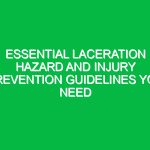“`html
Introduction
Good morning team! Today, we are going to discuss an essential topic: Essential Guidelines to Overcome Lack of Time in HSE Practices. As you know, health, safety, and Environment (HSE) practices are crucial in ensuring our workplace is safe and compliant. However, we often hear the excuse of not having enough time to implement these practices effectively. This Toolbox Talk will help us understand the importance of prioritizing HSE, even when time is tight, and offer practical steps to integrate Safety into our daily routines.
Understanding Essential Guidelines to Overcome Lack of Time in HSE Practices
So, what does it mean to overcome the lack of time in HSE practices? It refers to the strategies and methods we can adopt to ensure that health and safety protocols are not sidelined due to time constraints. When we prioritize HSE practices, we not only comply with Regulations but also create a safer work environment that can prevent accidents and injuries.
One common misconception is that safety practices are time-consuming and cumbersome. However, by integrating safety into our daily tasks efficiently, we can actually save time and avoid lengthy disruptions caused by accidents or incidents.
Key Hazards, Risks, and Safety Considerations
Failure to prioritize HSE practices can lead to serious Hazards and risks, including:
- Increased Accidents: Neglecting safety protocols can lead to workplace injuries, which can affect productivity and morale.
- Legal Ramifications: Non-compliance with safety regulations can result in legal consequences for both employees and the organization.
- Financial Loss: Accidents can lead to costly medical bills, insurance claims, and even fines from regulatory bodies.
Ignoring safety can have real-world consequences, such as increased absenteeism, lower employee morale, and reduced productivity. Understanding these risks is vital in motivating ourselves to make time for safety.
Best Practices, Procedures, & Actionable Advice
Now let’s explore some Best Practices to ensure that we can effectively manage our time while upholding HSE Standards:
1. Prioritize Safety in Daily Planning
When planning your daily tasks, always include safety checks and Procedures. This could mean allocating a few minutes at the start of each shift to review safety protocols or ensuring that safety equipment is readily available and functional.
2. Create a Safety Checklist
A checklist can serve as a quick reference to ensure that all safety protocols are followed without taking too much time. This checklist should include:
- Personal Protective Equipment (PPE) checks
- Equipment safety inspections
- Hazard assessments for the day’s tasks
3. Implement Micro-Training
Short, focused Training sessions can be more effective than long seminars. These sessions can be as brief as 10-15 minutes, focusing on specific safety topics relevant to our tasks.
4. Use Technology to Your Advantage
There are various safety management software and apps available that can help streamline safety practices. Consider using tools that allow for quick reporting of hazards or incidents.
5. Foster a Safety Culture
Encourage everyone to take ownership of safety. When employees feel responsible for their own safety and that of their colleagues, they are more likely to make time for HSE practices.
6. Learn from Real-Life Incidents
Reviewing case studies or incidents within our organization can provide valuable lessons. For example, if a colleague experienced an accident due to rushing through safety checks, discussing this openly can reinforce the need for prioritizing safety.
Regulations, Standards, and Compliance
Adhering to OSHA regulations and company-specific safety standards is crucial. Compliance is not just about avoiding fines; it is about ensuring the safety and well-being of everyone in the workplace.
Understanding the regulations can also help us identify what is required in our daily safety practices. For example, osha mandates that:
- Employers must provide a workplace free from recognized hazards.
- Employees must be trained on the hazards associated with their jobs.
Employee Engagement & Discussion
Now that we’ve covered some essential guidelines, let’s engage in a discussion. What safety challenges have you encountered related to time constraints? How can we work together to overcome these challenges and ensure that HSE practices are prioritized in our daily routines?
Conclusion & Key Takeaways
To wrap up, we have discussed the importance of overcoming the lack of time in HSE practices. By integrating safety into our daily routines, prioritizing it in our planning, and engaging in discussions, we can create a safer workplace. Remember, the goal is not just compliance, but fostering a culture of safety that protects us all.
Thank you all for your attention and commitment to making safety a priority in our work environment. Remember, every minute spent on safety is an investment in our well-being!
“`


